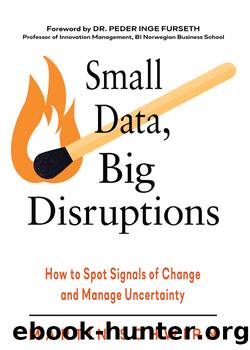Small Data, Big Disruptions by Martin Schwirn

Author:Martin Schwirn
Language: eng
Format: epub
ISBN: 9781632657435
Publisher: Red Wheel Weiser
Narratives Build Worlds
Forecasts limit your view. Big data looks at past information. Uncertainty does not afford a single perspective on the future. What is needed are worlds that allow you to roam freely to contemplate your options.
Ralston and Wilson provide the rationale: âWhile traditional responsesâimproved forecasting capability, better monitoring, greater flexibilityâare needed and commendable, they are inadequate to meet the full extent of this challenge. What is needed is a system geared to speculate not only about âthe future,â but about a range of possible futures.â23 What is needed is FIPI that lets you look at developing patterns and narratives to draw implications across the wide range of possibilities that the future offers from today's point of view.
Dufva looks at foresight, including scanning, âas a systematic practice for exploring futures: foresight is a process where a set of methods is used in a planned and rigorous manner (systematically) in order to create futures knowledge.â24 Crucially, futures knowledge does not represent âdeterministic forecasts.â Futures knowledge is a set of âjustifiable contingent plausibilities.â You want justifiable narratives to make sure that you are credible. Ground your thinking in realities; let real events and developments be your starting point in FIPI. Make narratives contingent; present dynamics to tell a story that captures decision-makers' imagination. Finally, do not fall into the trap to tell stories that veer off into worlds that listeners cannot follow. At the same time, don't attach likelihoods. âMake It Plausible, Not ProbableââOxford University scholars Angela Wilkinson and Roland Kupers highlight the mantra of anticipating futures.25 Whereas probability creates expectations, plausibility builds preparedness.
Traditional forecasts prevent comprehensive decision making. They present a very narrow look at the future. They limit your choice by showing you a narrow pathway. They lead you toward dangerous territory by excluding uncertainty. Narratives of potential futures, in contrast, open the corporate mind to vast opportunities and a virtually unlimited number of strategic alternatives that could find use. The challenge is obvious. You will see very different worlds that will require different responses to stay ahead of the game. But such narratives reflect reality; they present the future as it isâuncertain. But looking at alternative futures allows you to develop organizational intelligence. After allâaccording to American author F. Scott Fitzgeraldââthe test of a first-rate intelligence is the ability to hold two opposed ideas in the mind at the same time, and still retain the ability to function.â Scanning is the support to retain the ability to function.
Download
This site does not store any files on its server. We only index and link to content provided by other sites. Please contact the content providers to delete copyright contents if any and email us, we'll remove relevant links or contents immediately.
Hit Refresh by Satya Nadella(8983)
The Compound Effect by Darren Hardy(8719)
Change Your Questions, Change Your Life by Marilee Adams(7547)
Nudge - Improving Decisions about Health, Wealth, and Happiness by Thaler Sunstein(7443)
The Black Swan by Nassim Nicholas Taleb(6927)
Deep Work by Cal Newport(6797)
Daring Greatly by Brene Brown(6356)
Rich Dad Poor Dad by Robert T. Kiyosaki(6302)
Principles: Life and Work by Ray Dalio(6107)
Man-made Catastrophes and Risk Information Concealment by Dmitry Chernov & Didier Sornette(5862)
Playing to Win_ How Strategy Really Works by A.G. Lafley & Roger L. Martin(5708)
Digital Minimalism by Cal Newport;(5570)
Big Magic: Creative Living Beyond Fear by Elizabeth Gilbert(5541)
The Myth of the Strong Leader by Archie Brown(5358)
The Slight Edge by Jeff Olson(5309)
Discipline Equals Freedom by Jocko Willink(5229)
The Motivation Myth by Jeff Haden(5113)
Stone's Rules by Roger Stone(4981)
The Laws of Human Nature by Robert Greene(4910)
